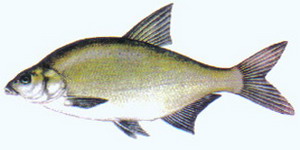

|

19 lbs |
10 oz |
00 drams |
08 kilos |
90 grams |
Year 2005 |
The Common Bream has a strikingly deep body with highly compressed sides and a distinctive mouth. Its dark back frequently has a greenish tinge with silvery grey sides and a whitish belly. Young fish are silvery, while the older Bream are dark and often have a golden lustre on their sides. Bream generally are found in large shoals, especially when young, favoring deep, slow or still water. The Bream can live to the ripe old age of 20 - 25 years.
Methods of Capture. Predominantly feeding on the soft bottom of ponds, lakes and the lower reaches of rivers, the Bream can be caught with legered baits or laying on with a waggler. Bream tend to shoal and move casually around looking for food. Large catches result from heavy feeding, effectively laying down a carpet of bait and groundbait whereupon the shoal once finding the food will stay either till disturbed or having 'mopped up' the food when they will move on. Baits such as Redworm and Castor can be used together quite successfully. Maggots, pinkies and chopped worm mixed in with Groundbait used liberally can provide a feeding ground for the shoal. The Bream has not got a reputation though as a fighting fish, generally
coming to the net with little resistance.
Once a shoal starts to feed, any fish hooked needs to be pulled away from the remainder quickly, otherwise the shoal will be spooked and will move on. Large weights can be caught provided the shoal stays over the feeding ground. A fairly consistent method is an open-end feeder filled with a groundbait mix combined with a hook length of 18 - 24 inches. Once cast in and the feeder reaches the bottom, take up the slack in the line and then pull the rod a further 18 inches or so. This will place the hook over the groundbait
©Norfolk Fishing Network 2004 - 2025®All Rights Reserved.